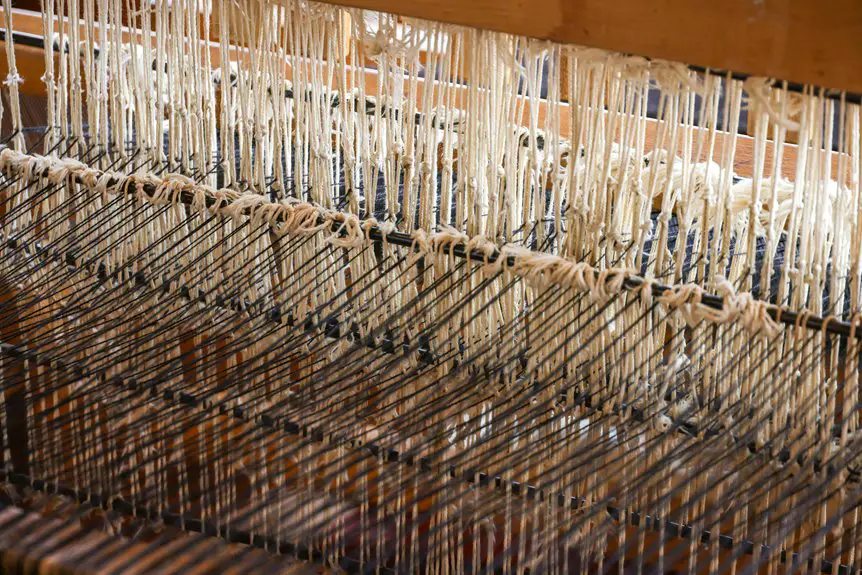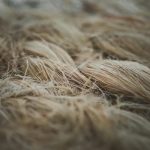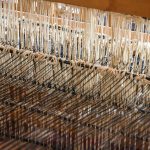When choosing between acetate and viscose, you’ll notice acetate offers a smooth, shiny finish with a delicate feel that needs gentle care, like dry cleaning or cold hand washing. Viscose feels softer and more breathable, resembling cotton with a matte look, but it can wrinkle and shrink if not handled carefully. Both come from cellulose but differ in production and durability. Keep exploring to understand their environmental impacts and best uses for your needs.
Table of Contents
Key Takeaways
- Acetate is chemically modified cellulose acetate with a smooth, glossy finish, while viscose is regenerated cellulose with a softer, matte texture.
- Acetate fibers are thermoplastic and delicate, requiring dry cleaning or cold hand washing; viscose is stronger but prone to shrinking and wrinkling.
- Acetate offers a luxurious, polished drape ideal for formal wear; viscose provides breathable comfort suited for casual clothing and home textiles.
- Both fibers originate from wood pulp but differ in chemical processing intensity and environmental impact, with sustainability varying by manufacturer.
- Acetate is commonly used in linings and evening gowns, whereas viscose is favored for dresses, blouses, and breathable fabrics.
Chemical Composition and Production Process
Although both acetate and viscose originate from cellulose, they differ markedly in their chemical composition and production processes.
Acetate and viscose both come from cellulose but differ significantly in chemistry and manufacturing.
You’ll find acetate is made by chemically modifying cellulose with acetic acid, forming cellulose acetate. This process involves dissolving cellulose and combining it with acetic anhydride, resulting in fibers with a thermoplastic nature.
On the other hand, viscose is produced by treating cellulose with chemicals like sodium hydroxide and carbon disulfide to create a viscous solution, which is then spun into fibers. Unlike acetate, viscose retains more of the original cellulose structure.
When you look at these differences, you can see why acetate behaves more like a synthetic fiber, while viscose is considered semi-synthetic. Understanding these distinctions helps you choose the right fabric for your needs.
Texture and Appearance
The feel and look of acetate and viscose differ noticeably, influencing how each fabric suits various garments and uses.
When you touch acetate, you’ll notice its smooth, silky surface that often shines with a subtle luster, giving your clothes a luxurious, polished appearance. It drapes elegantly, making it ideal for formal wear and linings.
On the other hand, viscose feels softer and more breathable, with a matte to semi-lustrous finish that mimics natural fibers like cotton or silk. You’ll find viscose has a slightly more textured surface, which adds a casual, comfortable vibe to your outfits.
Both fabrics offer versatility, but your choice depends on whether you want a glossy, refined look with acetate or a soft, natural feel with viscose.
Durability and Care Requirements
When you choose between acetate and viscose, understanding their durability and care needs can help you keep your garments looking their best.
Acetate tends to be more delicate and can weaken with prolonged exposure to moisture and heat, so you’ll want to handle it gently. Viscose is stronger but can shrink or wrinkle if not cared for properly.
Acetate is delicate and weakens with moisture and heat, while viscose is stronger but prone to shrinking and wrinkling.
Here’s how you can manage each fabric:
- Acetate: Dry clean or hand wash in cold water, avoid high heat when ironing, and store away from direct sunlight.
- Viscose: Hand wash or machine wash on a gentle cycle with cold water, reshape while damp, and iron on low heat.
- Both fabrics benefit from air drying to maintain shape and texture.
Following these tips will extend the life of your garments.
Environmental Impact and Sustainability
Taking care of acetate and viscose properly not only preserves their look but also affects their environmental footprint.
Acetate is derived from wood pulp and uses chemical processes involving acetic acid and solvents, which can impact ecosystems if not managed responsibly. However, some manufacturers now follow cleaner production methods to reduce waste and emissions.
Viscose, also made from cellulose, often involves more intensive chemical treatments that can lead to pollution if factories don’t implement strict controls. When you choose sustainably produced viscose or acetate, you support efforts to minimize deforestation and chemical discharge.
Also, both fibers are biodegradable, so disposing of them properly helps reduce long-term waste. By being mindful of how you care for and select these fabrics, you contribute to a smaller environmental impact overall.
Common Uses and Applications
You’ll find acetate and viscose in a wide range of products, from clothing to home textiles.
Both fabrics serve distinct purposes based on their properties, so knowing their common uses helps you choose the right one.
1. Acetate: Often used in linings, bridal gowns, and evening wear due to its smooth, silky appearance and excellent drape.
It’s also popular in decorative ribbons and upholstery.
2. Viscose: Favored for casual wear, dresses, and blouses because of its breathability and softness.
You’ll also see it in bed linens and curtains, where its comfort and drape shine.
3. Blended Fabrics: Both acetate and viscose blend well with other fibers, enhancing durability and comfort in activewear and fashion-forward garments.
Understanding these uses helps you pick the fabric that fits your project perfectly.
Frequently Asked Questions
Is Acetate or Viscose Better for Sensitive Skin?
If you have sensitive skin, you’ll want to choose viscose over acetate. Viscose is softer and more breathable, reducing irritation risks. Acetate can feel less comfortable and may cause more skin sensitivity for you.
Which Fabric Holds Dye Colors More Vibrantly?
Like a painter’s canvas, you want colors that pop and last. You’ll find acetate holds dye more vibrantly, shining bright like a jewel, while viscose tends to fade faster under sunlight and washes.
Are Acetate and Viscose Hypoallergenic?
You might find viscose generally more hypoallergenic since it’s made from natural fibers, but acetate can sometimes cause irritation due to chemical processing. Always test fabrics against your skin to avoid allergic reactions or discomfort.
Can Acetate or Viscose Be Used in Activewear?
You probably shouldn’t choose acetate for activewear since it lacks moisture-wicking and durability. Viscose can feel soft, but it absorbs sweat and dries slowly, so neither fabric is ideal for intense workouts or heavy sweating.
How Do Acetate and Viscose Fabrics Behave in Humid Conditions?
Think of acetate as a delicate flower wilting in the humid air—it struggles with moisture and loses shape. Viscose, however, feels like a sponge; it absorbs humidity, becoming heavier but staying soft, so you’ll notice the difference quickly.
- The Use of Nonwovens in Construction and Civil Engineering - July 11, 2025
- The Use of Nonwovens in Construction and Civil Engineering - July 11, 2025
- The Use of Nonwovens in Construction and Civil Engineering - July 11, 2025







